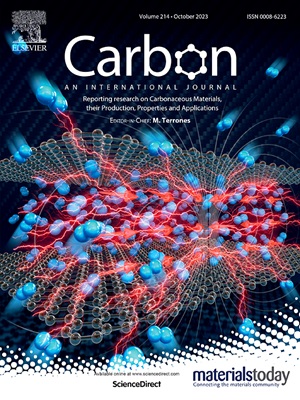Enhancement of high-temperature solar-blind UV photodetector performance on 4H–SiC substrates by deposition of ultrawide bandgap diamond films
IF 10.5
2区 材料科学
Q1 CHEMISTRY, PHYSICAL
引用次数: 0
Abstract
High-temperature operation and solar-blind ultraviolet (UV) sensitivity remain significant challenges for 4H–SiC-based photodetectors, limiting their performance in harsh environmental conditions. To address these issues, the deposition of ultrawide bandgap diamond films is employed to enhance the high-temperature performance of solar-blind UV photodetectors. Diamond films of varying thicknesses were deposited on 4H–SiC substrates using microwave plasma chemical vapor deposition. The photodetector achieves a maximum room-temperature responsivity of 0.12 A/W under 220 nm illumination with a 15 V bias, nearly 15 times higher than that observed in a 4H–SiC-only photodetector. Furthermore, the photodetectors exhibit exceptional UV/visible rejection ratios of 645, a photo-to-dark current ratio of 5.34 × 103, and a detectivity of 2.55 × 1012 Jones at room temperature. As the operating temperature increases, both the 220 nm responsivity and UV/visible rejection ratio improve, reaching approximately 0.6 A/W and 980 at 200 °C, respectively, which are 30 and 245 times higher than those of the pure SiC photodetector. The diamond films significantly enhance the solar-blind UV performance of SiC-based photodetectors at high temperatures.

求助全文
约1分钟内获得全文
求助全文
来源期刊

Carbon
工程技术-材料科学:综合
CiteScore
20.80
自引率
7.30%
发文量
0
审稿时长
23 days
期刊介绍:
The journal Carbon is an international multidisciplinary forum for communicating scientific advances in the field of carbon materials. It reports new findings related to the formation, structure, properties, behaviors, and technological applications of carbons. Carbons are a broad class of ordered or disordered solid phases composed primarily of elemental carbon, including but not limited to carbon black, carbon fibers and filaments, carbon nanotubes, diamond and diamond-like carbon, fullerenes, glassy carbon, graphite, graphene, graphene-oxide, porous carbons, pyrolytic carbon, and other sp2 and non-sp2 hybridized carbon systems. Carbon is the companion title to the open access journal Carbon Trends. Relevant application areas for carbon materials include biology and medicine, catalysis, electronic, optoelectronic, spintronic, high-frequency, and photonic devices, energy storage and conversion systems, environmental applications and water treatment, smart materials and systems, and structural and thermal applications.
 求助内容:
求助内容: 应助结果提醒方式:
应助结果提醒方式:


